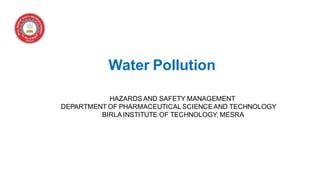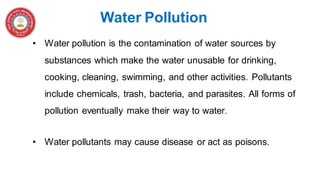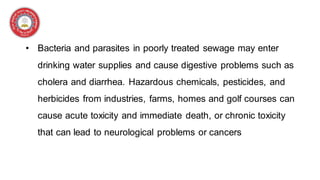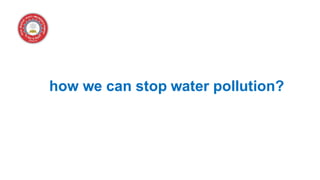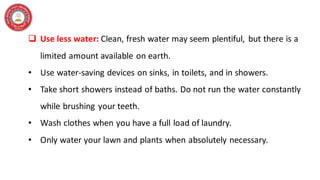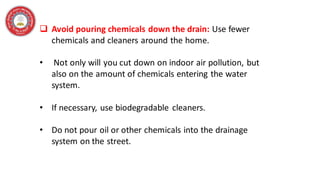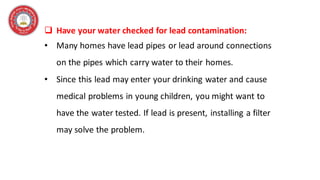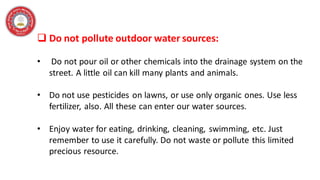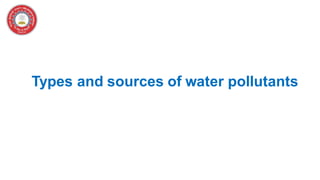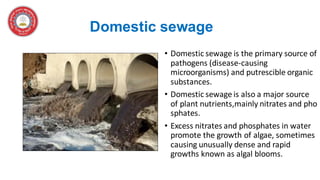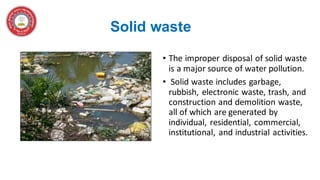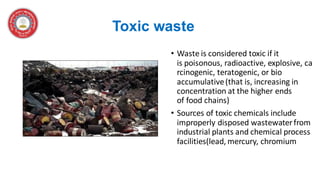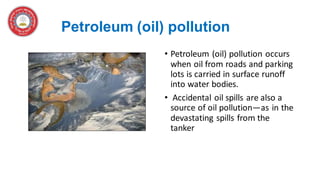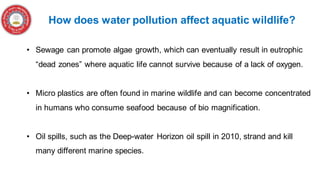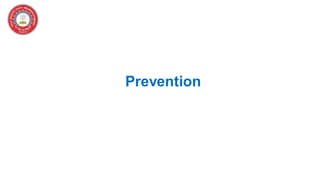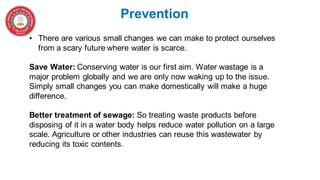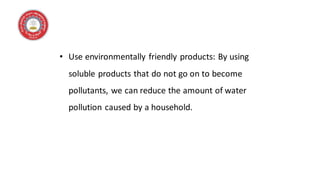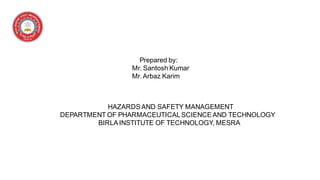water pollution
- 1. Water Pollution HAZARDSAND SAFETY MANAGEMENT DEPARTMENT OF PHARMACEUTICALSCIENCEAND TECHNOLOGY BIRLAINSTITUTE OF TECHNOLOGY, MESRA
- 2. • Water pollution is the contamination of water sources by substances which make the water unusable for drinking, cooking, cleaning, swimming, and other activities. Pollutants include chemicals, trash, bacteria, and parasites. All forms of pollution eventually make their way to water. • Water pollutants may cause disease or act as poisons. Water Pollution
- 3. • Bacteria and parasites in poorly treated sewage may enter drinking water supplies and cause digestive problems such as cholera and diarrhea. Hazardous chemicals, pesticides, and herbicides from industries, farms, homes and golf courses can cause acute toxicity and immediate death, or chronic toxicity that can lead to neurological problems or cancers
- 4. how we can stop water pollution?
- 5. ❑ Use less water: Clean, fresh water may seem plentiful, but there is a limited amount available on earth. • Use water-saving devices on sinks, in toilets, and in showers. • Take short showers instead of baths. Do not run the water constantly while brushing your teeth. • Wash clothes when you have a full load of laundry. • Only water your lawn and plants when absolutely necessary.
- 6. ❑ Avoid pouring chemicals down the drain: Use fewer chemicals and cleaners around the home. • Not only will you cut down on indoor air pollution, but also on the amount of chemicals entering the water system. • If necessary, use biodegradable cleaners. • Do not pour oil or other chemicals into the drainage system on the street.
- 7. ❑ Have your water checked for lead contamination: • Many homes have lead pipes or lead around connections on the pipes which carry water to their homes. • Since this lead may enter your drinking water and cause medical problems in young children, you might want to have the water tested. If lead is present, installing a filter may solve the problem.
- 8. ❑ Do not pollute outdoor water sources: • Do not pour oil or other chemicals into the drainage system on the street. A little oil can kill many plants and animals. • Do not use pesticides on lawns, or use only organic ones. Use less fertilizer, also. All these can enter our water sources. • Enjoy water for eating, drinking, cleaning, swimming, etc. Just remember to use it carefully. Do not waste or pollute this limited precious resource.
- 9. Types and sources of water pollutants
- 10. Domestic sewage • Domestic sewage is the primary source of pathogens (disease-causing microorganisms) and putrescible organic substances. • Domestic sewage is also a major source of plant nutrients,mainly nitrates and pho sphates. • Excess nitrates and phosphates in water promote the growth of algae, sometimes causing unusually dense and rapid growths known as algal blooms.
- 11. Solid waste • The improper disposal of solid waste is a major source of water pollution. • Solid waste includes garbage, rubbish, electronic waste, trash, and construction and demolition waste, all of which are generated by individual, residential, commercial, institutional, and industrial activities.
- 12. Toxic waste • Waste is considered toxic if it is poisonous, radioactive, explosive, ca rcinogenic, teratogenic, or bio accumulative(that is, increasing in concentration at the higher ends of food chains) • Sources of toxic chemicals include improperly disposed wastewaterfrom industrial plants and chemical process facilities(lead, mercury, chromium
- 13. Petroleum (oil) pollution • Petroleum (oil) pollution occurs when oil from roads and parking lots is carried in surface runoff into water bodies. • Accidental oil spills are also a source of oil pollution—as in the devastating spills from the tanker
- 14. How does water pollution affect aquatic wildlife? • Sewage can promote algae growth, which can eventually result in eutrophic “dead zones” where aquatic life cannot survive because of a lack of oxygen. • Micro plastics are often found in marine wildlife and can become concentrated in humans who consume seafood because of bio magnification. • Oil spills, such as the Deep-water Horizon oil spill in 2010, strand and kill many different marine species.
- 15. Prevention
- 16. Prevention • There are various small changes we can make to protect ourselves from a scary future where water is scarce. Save Water: Conserving water is our first aim. Water wastage is a major problem globally and we are only now waking up to the issue. Simply small changes you can make domestically will make a huge difference. Better treatment of sewage: So treating waste products before disposing of it in a water body helps reduce water pollution on a large scale. Agriculture or other industries can reuse this wastewater by reducing its toxic contents.
- 17. • Use environmentally friendly products: By using soluble products that do not go on to become pollutants, we can reduce the amount of water pollution caused by a household.
- 18. HAZARDSAND SAFETY MANAGEMENT DEPARTMENT OF PHARMACEUTICALSCIENCEAND TECHNOLOGY BIRLAINSTITUTE OF TECHNOLOGY, MESRA Prepared by: Mr. Santosh Kumar Mr. Arbaz Karim
